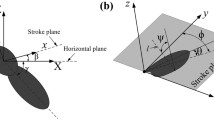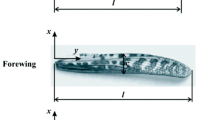Summary
- 1.
The pterostigma of insect wings usually is a pigmented spot close to the leading edge far out on the wing, having a greater mass than an equally large wing piece in adjacent wing regions.
- 2.
In several dragonfly (Odonata) species the position of the spanwise torsion axis of the wings, the mass distribution of the wings, and the position of the chordwise centre of mass in chordwise wing strips were determined.
- 3.
In the dragonflies investigated, the torsion axis of the wing lies ahead of the chordwise centre of mass of the wing except at the pterostigma (Fig. 1).
- 4.
A wing having its mass axis behind its torsion axis is very susceptible to self-excited coupled flapping and feathering vibrations, making gliding flight above a critical speed impossible. Due to unfavourable, inertial, wing pitching tendencies, a still lower speed limit is set to active flight.
- 5.
Due to its mass contribution and favourable location, the pterostigma tends to raise these speed limits by causing favourable, inertial, pitching moments during the acceleration phases of wing flapping.
- 6.
The favourable pitching moment of the pterostigma is proportional to the distance from the wing base to the pterostigma, and to the distance of the pterostigma ahead of the wing's spanwise torsion axis. The pterostigma usually has an optimal position at the leading edge of the wing near the wing tip, just where the wing curves backwards. Further optimization of pterostigma mass localization has been obtained in different ways in various insects, involving both pterostigma position (Fig. 4) and form (Fig. 5a).
- 7.
The function of the pterostigma of raising the critical gliding speed, at which self-excited vibrations set in, was demonstrated in dragonflies. Although contributing only 0.1 % (one pterostigma) of the total dragonfly weight, it raised the critical speed by 10–25% in one species.
- 8.
The pterostigma is common among the insect orders Odonata, Neuroptera, Psocoptera, Hemiptera, and Hymenoptera. By passive, inertial, pitch angle control, the pterostigma probably makes the wing beat more efficient in slow and hovering flight of small insects, while its raising of the critical flight speeds probably is of more importance to larger insects. The ability of active pitch angle control in many insects does not detract from the value of the pterostigma, since it contributes passively, without power expenditure, towards an efficient wing stroke.
Similar content being viewed by others
References
Andersen, S. O., Weis-Fogh, T.: Resilin. A rubber-like protein in arthropod cuticle. In: Advances in insect physiology2, 1–65 (1964).
Boettiger, E. G., Fursphan, E.: The mechanics of flight movement in Diptera. Biol. Bull.102, 200–211 (1952).
Esben-Petersen, P.: Netvinger og skorpionfluer (Neuroptera & Mecoptera). Danmarks Fauna33, København: Gads Forlag 1929.
Grasse, P. -P., ed.: Traité de zoologie 10, Fascicule 2. Paris: Masson et Cie 1951.
Greenewalt, C. H.: The wings of insects and birds as mechanical oscillators. Proc. Amer. phil. Soc.105, 605–611 (1960).
Hertel, H.: Structure, form, movement. New York: Reinhold Publ. Corp. 1966.
Landin, B.-O.: Insekter 1. Stockholm: Natur och Kultur 1967.
Needham, J. G.: A geneologic study of dragon-fly wing-venation. Proc. U.S. nat. Mus.26, 703–764 (1903).
Neville, A. C.: Aspects of flight mechanics in anisopterous dragonflies. J. exp. Biol.37, 631–656 (1960).
Nielsen, J. C., Henriksen, K.: Trae-og bladhvepse (Hymenoptera phytophaga). Danmarks Fauna 18. København: Gads Forlag 1915.
Russenberger, H., Eussenberger, M.: Bau und Wirkungsweise des Flugapparates von Libellen, mit besonderer Berücksichtigung vonAeschna cyanea. Mitt. naturf. Ges. Schaffhausen27, 1–88 (1959/60).
Shapiro, J.: Principles of helicopter engineering. London: Temple Press 1955.
Sotavalta, O.: The effect of wing inertia on the wing-stroke frequency of moths, dragonflies and cockroach. Ann. ent. fenn.20, 93–101 (1954).
Weis-Fogh, T.: A rubber-like protein in insect cuticle. J. exp. Biol.37, 889–907 (1960).
Weis-Fogh, T.: Energetics of hovering flight in hummingbirds and inDrosophila. J. exp. Biol.56, 79–104 (1972).
Author information
Authors and Affiliations
Rights and permissions
About this article
Cite this article
Åke Norberg, R. The pterostigma of insect wings an inertial regulator of wing pitch. J. Comp. Physiol. 81, 9–22 (1972). https://doi.org/10.1007/BF00693547
Received:
Issue Date:
DOI: https://doi.org/10.1007/BF00693547




